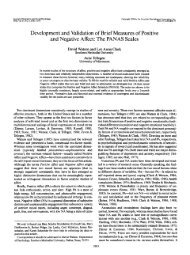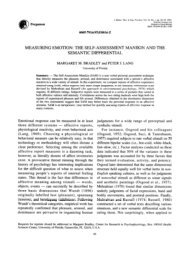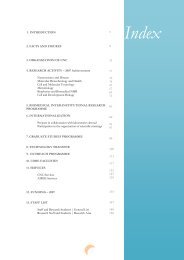Annual Report of Activities CNC 2008 - Center for Neuroscience and ...
Annual Report of Activities CNC 2008 - Center for Neuroscience and ...
Annual Report of Activities CNC 2008 - Center for Neuroscience and ...
You also want an ePaper? Increase the reach of your titles
YUMPU automatically turns print PDFs into web optimized ePapers that Google loves.
Inorganic Biochemistry <strong>and</strong> Molecular Imaging | Head: Carlos GeraldesObjectivesOur general objective is the study <strong>of</strong> inorganiccompounds <strong>for</strong> medical diagnostic imaging (inparticular MRI contrast agents), inorganic drugs <strong>for</strong>medical therapy, <strong>and</strong> the study <strong>of</strong> environmental<strong>and</strong> toxicological effects <strong>of</strong> inorganic species. Thedesign <strong>and</strong> development <strong>of</strong> metal based agents <strong>for</strong>multimodal targeted molecular imaging agents, isfollowed by in vitro cell studies <strong>and</strong> animal modelevaluation using MRI <strong>and</strong> nuclear imagingtechniques. These agents include Ln3+‐basedparamagnetic nanoparticles with interestingphotoluminescence properties <strong>for</strong> optical imaging(OI), <strong>and</strong> high r2 relaxivities, especially at highfields, yielding negative contrast in T2‐weightedMRI images. The r1 relaxivity <strong>of</strong> new lanthanidechelates will be increased by designing newchelating agents which increase the number <strong>of</strong> innersphere water molecules <strong>and</strong> optimize the waterexchange rates. Second‐sphere water relaxationcontributions should also be optimized.We also study the molecular <strong>and</strong> cellularmechanisms <strong>of</strong> action <strong>of</strong> lithium salts in thetherapy <strong>of</strong> the bipolar disorder, using cell <strong>and</strong>animal systems, in particular by studying the Li+effects on the adult rat brain <strong>and</strong> in primarycultures <strong>of</strong> cortical neurons <strong>and</strong> astrocytes duringthe metabolism <strong>of</strong> (1‐13C) glucose or (2‐13C) using13C NMR <strong>of</strong> organ <strong>and</strong> cell extracts, in order toclarify the effects <strong>of</strong> Li+ on glutamatergic <strong>and</strong>GABAergic neurotransmission.Several types <strong>of</strong> new inorganic vanadium(IV/V)complexes are synthesised, chemicallycharacterized in aqueous solution <strong>and</strong> theirpotential use as efficient oral insulin‐enhancingagents <strong>for</strong> type II diabetes <strong>and</strong> toxicity effects isinvestigated in different cell systems.Environmental <strong>and</strong> toxicological effects <strong>of</strong>inorganic species <strong>of</strong> Cr(VI) are investigated byimplementation <strong>of</strong> an in vitro model to study themultistage bronchial epithelial carcinogenesisinduced by Cr(VI).Other projects in Inorganic Chemistry include a)NMR structural <strong>and</strong> DFT theoretical studies <strong>of</strong>end‐capped conjugated oligomers <strong>and</strong> polymers<strong>for</strong> molecular electronic device applications, <strong>of</strong>poly(9,9‐dialkylfluorene)s, <strong>of</strong> luminescent gold(I)compounds <strong>and</strong> <strong>of</strong> organic compounds relevant inthe production <strong>of</strong> zeolite‐type materials <strong>for</strong> gasstorage <strong>and</strong> molecular selection; b) studies <strong>of</strong> metalion interactions with polyelectrolytes.Main Achievements1)Ln3+ paramagnetic nanoparticles (NPs) areuseful <strong>for</strong> molecular imaging (MI) applications: Lnsilicates containing Eu;Tb/Gd, with tuneablephotoluminescence properties <strong>for</strong> OI; aqueous Lnzeolite‐typesilicate (Ln‐AV‐9) have high r2* <strong>and</strong> r2relaxivities, useful reporter groups <strong>for</strong> highfieldT2w or T2w* MRI; 2) A Gd3+‐substitutedDTTA complex has improved properties relative tothe parent DTTA; the Gd3+ complexes <strong>of</strong> 5phospho(i)nate lig<strong>and</strong>s lacking an inner‐spherewater molecule, have a significant contribution <strong>of</strong>second‐sphere water to r1 relaxivity; 3)In vivoproperties <strong>of</strong> potential MRI CAs: Ln3+ complexes<strong>of</strong> 6 DOTA‐tetraamide lig<strong>and</strong>s (ParaCEST agents),labeled with 153Gd or 177Lu, with renal excretion<strong>and</strong> no dissociation in vivo in Wistar rats, but allthree tri‐cationic complexes studied are acutelytoxic to the heart at MRI CA doses; Gd3+ chelateswere evaluated by DCE MRI in vivo: i) Gd3L (atrimeric DTTA chelate) has high r1 at high fields<strong>and</strong> MRI experiments at B0 = 9.4 T in mice showedmuch higher signal enhancement in the kidneymedulla <strong>and</strong> cortex than the commercial GdDOTAat an identical dose; ii) micellar Gd3+ chelate <strong>of</strong>EPTPAC16 targeted to the RES, give strongpositive liver contrast in T1w images (resultssupported by studies with the 153Sm3+‐labeledcompounds; 4)Li+ effects on metabolism <strong>of</strong> (1‐13C)glucose or (2‐13C) acetate in rat brain <strong>and</strong> primarycultures <strong>of</strong> neurons <strong>and</strong> astrocytes wereinvestigated by 13C NMR, indicating that Li+effects are mediated through a reduction <strong>of</strong>neuronal glucose uptake resulting in a decrease <strong>of</strong>glutamatergic <strong>and</strong> GABAergic neurotransmissionwithout effects on astrocytic metabolism;5)Aqueous speciation <strong>of</strong> the pyrimidinone complex(VV‐MHCPE) gives (VVO2)L2 <strong>and</strong> (VVO2)LH−1main species. Cytotoxicity study <strong>of</strong> this, apyridinone <strong>and</strong> a salicylaldehyde VV‐complexesshowed potential antitumor activity <strong>for</strong> VV‐MHCPE; 6) An in vitro model <strong>of</strong> Cr(VI)‐inducedmalignant trans<strong>for</strong>mation <strong>of</strong> human bronchialepithelial cells was implemented.69






